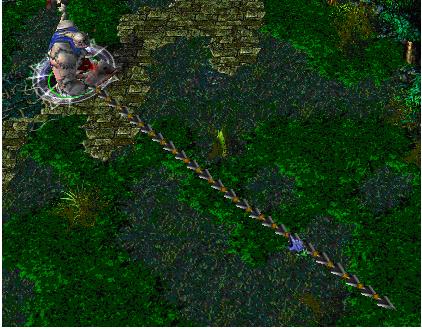Just a Hook
Time Limit: 4000/2000 MS (Java/Others) Memory Limit: 32768/32768 K (Java/Others)Total Submission(s): 29899 Accepted Submission(s): 14769
Problem Description
In the game of DotA, Pudge’s meat hook is actually the most horrible thing for most of the heroes. The hook is made up of several consecutive metallic sticks which are of the same length.

Now Pudge wants to do some operations on the hook.
Let us number the consecutive metallic sticks of the hook from 1 to N. For each operation, Pudge can change the consecutive metallic sticks, numbered from X to Y, into cupreous sticks, silver sticks or golden sticks.
The total value of the hook is calculated as the sum of values of N metallic sticks. More precisely, the value for each kind of stick is calculated as follows:
For each cupreous stick, the value is 1.
For each silver stick, the value is 2.
For each golden stick, the value is 3.
Pudge wants to know the total value of the hook after performing the operations.
You may consider the original hook is made up of cupreous sticks.

Now Pudge wants to do some operations on the hook.
Let us number the consecutive metallic sticks of the hook from 1 to N. For each operation, Pudge can change the consecutive metallic sticks, numbered from X to Y, into cupreous sticks, silver sticks or golden sticks.
The total value of the hook is calculated as the sum of values of N metallic sticks. More precisely, the value for each kind of stick is calculated as follows:
For each cupreous stick, the value is 1.
For each silver stick, the value is 2.
For each golden stick, the value is 3.
Pudge wants to know the total value of the hook after performing the operations.
You may consider the original hook is made up of cupreous sticks.
Input
The input consists of several test cases. The first line of the input is the number of the cases. There are no more than 10 cases.
For each case, the first line contains an integer N, 1<=N<=100,000, which is the number of the sticks of Pudge’s meat hook and the second line contains an integer Q, 0<=Q<=100,000, which is the number of the operations.
Next Q lines, each line contains three integers X, Y, 1<=X<=Y<=N, Z, 1<=Z<=3, which defines an operation: change the sticks numbered from X to Y into the metal kind Z, where Z=1 represents the cupreous kind, Z=2 represents the silver kind and Z=3 represents the golden kind.
For each case, the first line contains an integer N, 1<=N<=100,000, which is the number of the sticks of Pudge’s meat hook and the second line contains an integer Q, 0<=Q<=100,000, which is the number of the operations.
Next Q lines, each line contains three integers X, Y, 1<=X<=Y<=N, Z, 1<=Z<=3, which defines an operation: change the sticks numbered from X to Y into the metal kind Z, where Z=1 represents the cupreous kind, Z=2 represents the silver kind and Z=3 represents the golden kind.
Output
For each case, print a number in a line representing the total value of the hook after the operations. Use the format in the example.
Sample Input
1 10 2 1 5 2 5 9 3
Sample Output
Case 1: The total value of the hook is 24.
Source
Recommend
wangye
题意:有一个棍子很长分为很多节,每节都有不同的材料 价值为1 2 3 组成,初始化状态认为全部节价值为用价值为1的材料组成,有Q个操作,每个操作有3个数x y num,即从x到y 的节材料改成价值为num的材料,问最后这根棍子总价值为多少
解题思路:线段树,但不能更新到叶子节点,要成段更新,每个节点加个延迟标记
#include <iostream>
#include <cstdio>
#include <string>
#include <cstring>
#include <cmath>
#include <queue>
#include <vector>
#include <set>
#include <stack>
#include <map>
#include <climits>
using namespace std;
#define LL long long
const int INF=0x3f3f3f3f;
const int MAXN=200001;
struct node
{
int l,r,flag,sum;
}b[MAXN*4];
void build(int k,int l,int r)
{
b[k].l=l,b[k].r=r,b[k].flag=0;
if (l==r)
{
b[k].sum=1;
return;
}
int mid=(l+r)>>1;
build(k<<1,l,mid);
build(k<<1|1,mid+1,r);
b[k].sum=b[k<<1].sum+b[k<<1|1].sum;
}
void update(int k,int l,int r,int v)
{
if(b[k].l>=l&&b[k].r<=r)
{
b[k].flag=v;
b[k].sum=v*(b[k].r-b[k].l+1);
return;
}
if(b[k].flag)
{
b[k<<1].flag=b[k].flag;
b[k<<1|1].flag=b[k].flag;
b[k<<1].sum=b[k].flag*(b[k<<1].r-b[k<<1].l+1);
b[k<<1|1].sum=b[k].flag*(b[k<<1|1].r-b[k<<1|1].l+1);
b[k].flag=0;
}
int mid=(b[k].l+b[k].r)>>1;
if(mid>=l) update(k<<1,l,r,v);
if(mid<r) update(k<<1|1,l,r,v);
b[k].sum=b[k<<1].sum+b[k<<1|1].sum;
}
int main()
{
int n,t,q,cas=0;
scanf("%d",&t);
while(t--)
{
scanf("%d%d",&n,&q);
build(1,1,n);
int l,r,v;
while(q--)
{
scanf("%d %d %d",&l,&r,&v);
update(1,l,r,v);
}
printf("Case %d: The total value of the hook is %d.\n",++cas,b[1].sum);
}
return 0;
}

























 357
357

 被折叠的 条评论
为什么被折叠?
被折叠的 条评论
为什么被折叠?








